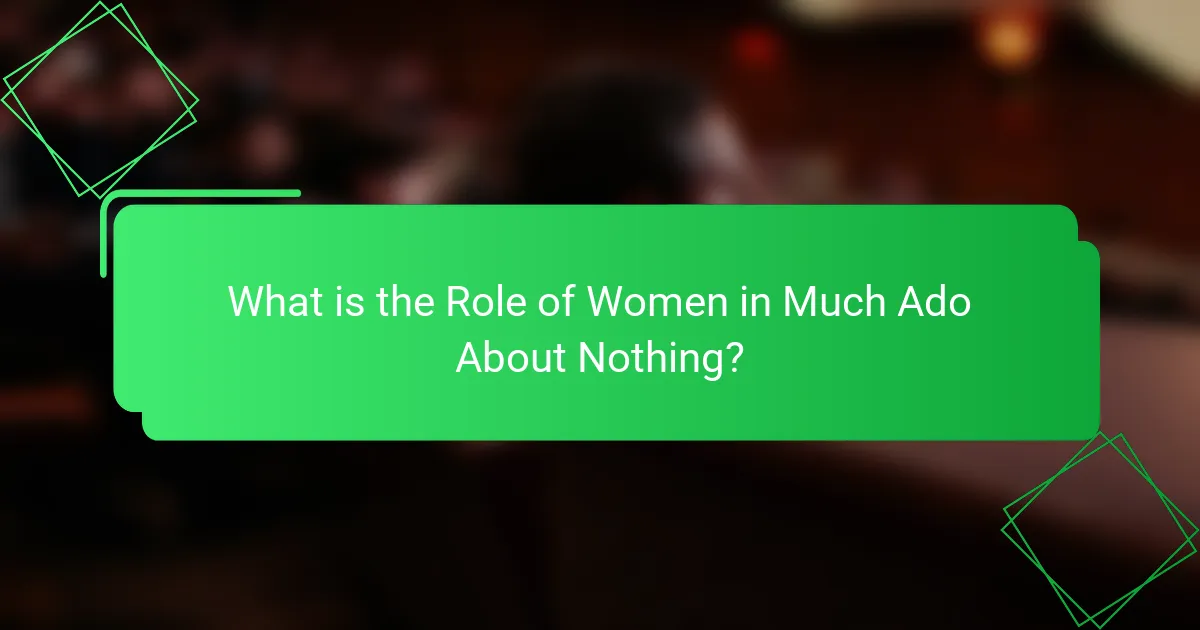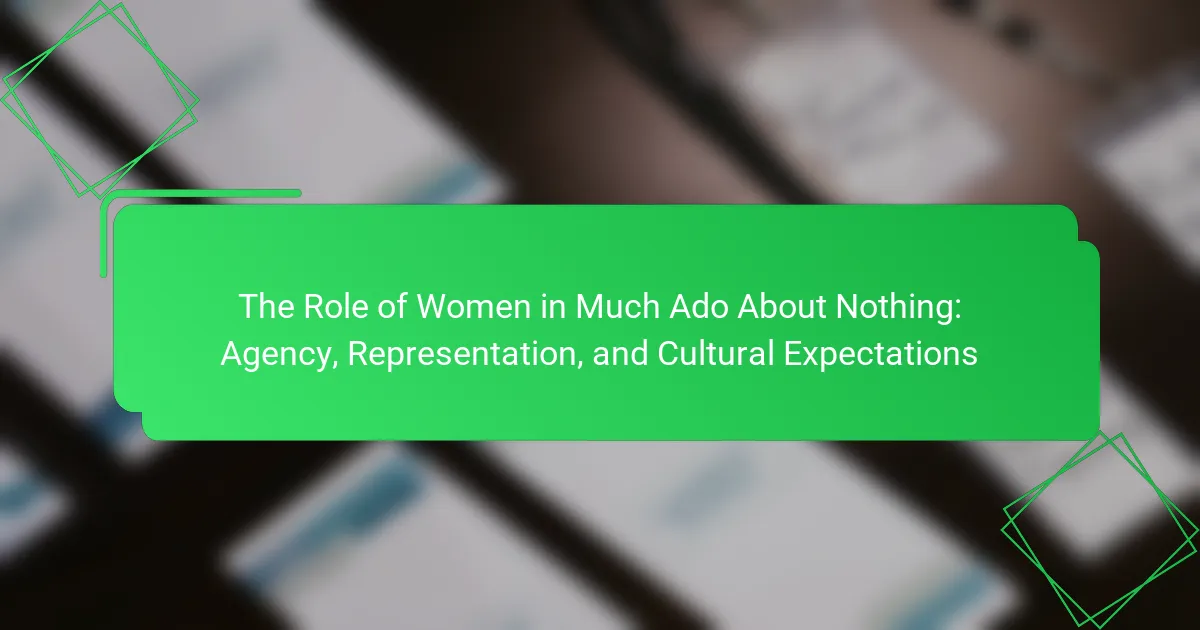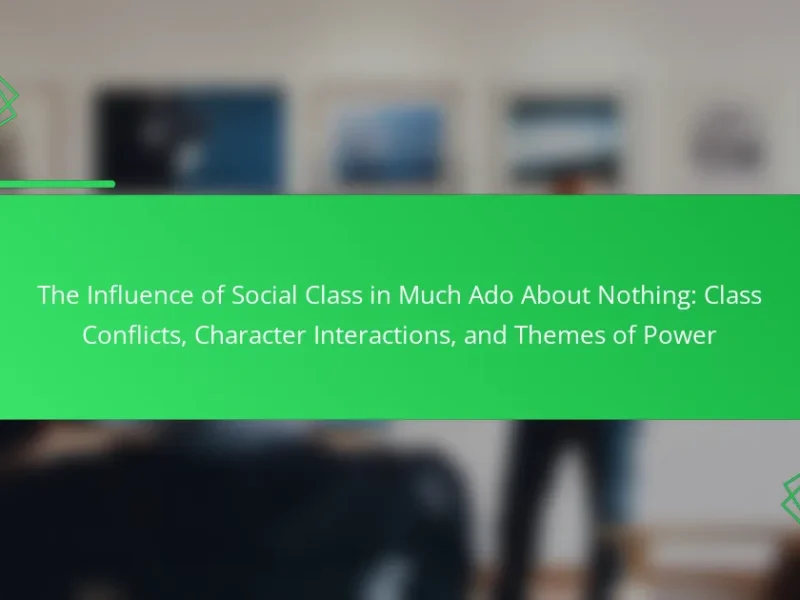
What is the Role of Women in Much Ado About Nothing?
The role of women in Much Ado About Nothing is significant in illustrating themes of agency and societal expectations. Characters like Beatrice and Hero represent different aspects of femininity. Beatrice embodies independence and wit, challenging traditional gender roles. She actively participates in conversations and critiques societal norms. Hero, in contrast, exemplifies the idealized woman of the time, showcasing obedience and virtue. Her storyline emphasizes the consequences of male authority and societal judgment. The interactions between these women highlight the tension between personal desire and societal expectations. Their roles reflect the complexities of gender dynamics in the Elizabethan era. Ultimately, the play critiques and reflects the limitations placed on women during this period.
How do women’s roles reflect agency in the play?
Women’s roles in Much Ado About Nothing reflect agency through their ability to influence events and assert their voices. Characters like Beatrice and Hero demonstrate independence and strength. Beatrice challenges societal norms by expressing her opinions openly. Hero, while more traditional, asserts her agency through her actions and the defense of her honor. Their interactions with male characters highlight their influence on the plot. For instance, Beatrice’s wit and intelligence drive much of the dialogue. The play showcases how these women navigate and manipulate their circumstances. This portrayal of agency illustrates the complexities of female roles in a patriarchal society.
What specific actions demonstrate women’s agency in Much Ado About Nothing?
Beatrice’s witty dialogue showcases her independence and refusal to conform. She challenges societal norms through her sharp repartee. Hero asserts her agency by actively participating in her courtship with Claudio. She expresses her feelings and desires openly. Margaret, though a minor character, influences events through her interactions. Her involvement in the deception highlights women’s roles in shaping narratives. Additionally, Beatrice’s demand for Benedick to prove his love exemplifies her assertiveness. These actions collectively illustrate women’s agency within the constraints of their society.
How do the characters of Beatrice and Hero exemplify different forms of agency?
Beatrice and Hero exemplify different forms of agency in “Much Ado About Nothing.” Beatrice demonstrates assertive agency through her outspoken nature and wit. She actively challenges societal norms and expresses her opinions on love and marriage. Her famous line, “I had rather hear my dog bark at a crow than a man swear he loves me,” illustrates her independence. In contrast, Hero embodies passive agency. She conforms to societal expectations of femininity and obedience. Hero’s silence and submissiveness reflect the limited agency afforded to women in her time. Her character ultimately showcases the consequences of societal pressures on women’s autonomy. Beatrice’s boldness and Hero’s compliance highlight the spectrum of agency among women in the play.
What does representation of women in the play reveal about cultural expectations?
The representation of women in the play reveals significant cultural expectations regarding gender roles. In “Much Ado About Nothing,” women are often portrayed as obedient and subservient. Characters like Hero embody the ideal of female virtue, emphasizing the importance of chastity and loyalty. Conversely, Beatrice challenges these norms with her wit and independence, highlighting the tension between societal expectations and individual agency. The contrast between these characters illustrates the limited roles available to women in the Elizabethan era. Women’s actions are frequently dictated by the male characters, reflecting a patriarchal society. This dynamic underscores the cultural belief that women’s worth is tied to their relationships with men. Overall, the play critiques and reflects the restrictive cultural expectations placed on women during its time.
How are female characters portrayed in relation to societal norms of the time?
Female characters in “Much Ado About Nothing” are portrayed as reflections of the societal norms of the Elizabethan era. They often embody the expectations of obedience and chastity. For instance, Hero represents the ideal woman, submissive and loyal to her father and husband. Beatrice, in contrast, challenges these norms by displaying independence and wit. However, her character ultimately conforms to societal expectations by marrying. The play illustrates the tension between individual agency and societal constraints. Historical context reveals that women had limited rights and were often viewed as property. This portrayal highlights the struggle for female autonomy within a patriarchal framework.
What contrasts exist between Beatrice and Hero in terms of representation?
Beatrice and Hero represent contrasting ideals of femininity in “Much Ado About Nothing.” Beatrice embodies independence and wit. She challenges societal norms and expresses her opinions openly. In contrast, Hero represents traditional femininity and obedience. She is passive and conforms to societal expectations of women. Beatrice’s outspoken nature highlights her agency. Hero’s silence during key moments emphasizes her lack of control. Their differences illustrate varying responses to male dominance. Beatrice’s strength contrasts sharply with Hero’s vulnerability. This juxtaposition reflects broader cultural expectations of women during the play’s setting.
How do the relationships between male and female characters shape the narrative?
The relationships between male and female characters shape the narrative by influencing character development and plot progression. In “Much Ado About Nothing,” these relationships highlight societal expectations and gender dynamics. For instance, the courtship between Beatrice and Benedick showcases the theme of wit and independence. Their banter reflects the tension between traditional roles and personal agency. Conversely, the relationship between Claudio and Hero emphasizes the consequences of societal judgment. Claudio’s public shaming of Hero illustrates the vulnerability of women in a patriarchal society. These interactions drive the narrative forward, revealing deeper themes of love, honor, and betrayal. Ultimately, the interplay between male and female characters enriches the story’s complexity and emotional resonance.
What role do male characters play in influencing women’s choices?
Male characters significantly influence women’s choices in “Much Ado About Nothing.” Their actions and decisions often dictate the social dynamics and expectations faced by female characters. For instance, Claudio’s public shaming of Hero leads to her temporary disempowerment. This event showcases how male judgment can alter a woman’s social standing. Additionally, Benedick’s eventual support of Beatrice empowers her to assert her own desires. This shift illustrates how male characters can also provide agency to women. The interplay between male actions and female responses highlights the cultural expectations of the time. These dynamics underscore the broader themes of agency and representation within the play.
How do power dynamics manifest in the interactions between genders?
Power dynamics in gender interactions often reveal imbalances in authority and influence. In many societies, traditional roles assign men greater power and decision-making capabilities. This can manifest in communication styles, where men may dominate conversations, while women are often expected to be more submissive. Studies show that women frequently face interruptions and are less likely to be listened to in mixed-gender settings.
In “Much Ado About Nothing,” these dynamics are evident in character interactions. For example, Benedick and Beatrice engage in witty banter, yet Benedick’s opinions often hold more weight in their society. Additionally, Claudio’s public shaming of Hero illustrates how male authority can impact female reputation and agency.
Research indicates that power dynamics can also influence perceptions of competence. Women are often judged more harshly than men for similar behaviors. This reinforces societal stereotypes and limits women’s roles. Overall, power dynamics shape gender interactions, affecting communication, authority, and representation.
What implications does the portrayal of women have on modern interpretations?
The portrayal of women in literature significantly influences modern interpretations of their roles. It shapes societal views on gender expectations and agency. For instance, female characters often reflect or challenge cultural norms. This can lead to increased awareness of gender inequality. In “Much Ado About Nothing,” characters like Beatrice and Hero embody these complexities. Their actions and dialogues prompt discussions about women’s autonomy. Studies show that modern audiences resonate with strong female representations. This connection can inspire a reevaluation of traditional gender roles in contemporary society.
How can understanding the role of women in Much Ado About Nothing inform contemporary discussions on gender?
Understanding the role of women in Much Ado About Nothing highlights the complexities of gender dynamics. The characters of Beatrice and Hero exemplify differing expressions of female agency. Beatrice challenges societal norms through her wit and independence. Hero, in contrast, represents the traditional expectations of women in her submissiveness. Their interactions reveal the societal pressures placed on women in the Elizabethan era.
These portrayals can inform contemporary discussions on gender by illustrating the ongoing struggle for women’s agency. The text encourages reflection on how societal expectations shape gender roles today. By analyzing these characters, modern audiences can better understand the historical context of women’s rights. This understanding fosters dialogue on current gender inequalities and the importance of agency in women’s lives.
What lessons can be drawn from the play regarding gender roles today?
The play illustrates that gender roles are often rigid and culturally constructed. Women in the play face societal expectations that limit their agency. For example, Hero’s honor is tied to her chastity, reflecting the historical context of women’s value being linked to their purity. Beatrice challenges these norms through her wit and independence, suggesting that women can assert themselves. The contrast between Hero and Beatrice highlights the diverse expressions of femininity. Today, these lessons encourage discussions about redefining gender expectations. They also promote the importance of women’s voices in societal narratives.
How can the themes of agency and representation be applied to current societal issues?
The themes of agency and representation can be applied to current societal issues by highlighting the importance of women’s voices and choices. Agency refers to the capacity of individuals to act independently and make their own choices. Representation involves how individuals or groups are portrayed in media and society.
In contemporary society, women often face barriers to agency, such as societal norms and stereotypes. For instance, research shows that women are underrepresented in leadership roles across various sectors. According to a 2021 report by McKinsey & Company, women hold only 28% of senior vice president roles in the corporate world.
This lack of representation affects women’s ability to influence decision-making processes. When women are not adequately represented, their perspectives and experiences are often overlooked. This can lead to policies and practices that do not address their needs.
Moreover, the portrayal of women in media significantly impacts societal perceptions. Stereotypical representations can reinforce harmful norms and limit women’s agency. Conversely, diverse and realistic portrayals can empower women and encourage societal change.
Overall, applying the themes of agency and representation to current societal issues emphasizes the need for greater inclusivity and equity for women in all areas of life.
What are practical insights for analyzing women’s roles in Shakespearean literature?
Analyzing women’s roles in Shakespearean literature requires a focus on character agency and societal context. Female characters often navigate patriarchal constraints. For instance, Beatrice in “Much Ado About Nothing” displays wit and independence. This challenges traditional gender norms of Shakespeare’s time. Additionally, examining dialogue reveals insights into women’s perspectives. Women’s interactions with male characters often reflect societal expectations. The portrayal of women can also highlight themes of power and vulnerability. Historical context enhances understanding of these roles. Research by authors such as Linda Bamber emphasizes the significance of female agency in Shakespeare’s works. This approach provides a comprehensive analysis of women’s representation in literature.
The main entity of the article is “The Role of Women in Much Ado About Nothing.” This article examines the significant roles of female characters Beatrice and Hero, highlighting their expressions of agency and the societal expectations placed upon them in the Elizabethan era. It explores how Beatrice embodies independence and challenges traditional gender norms, while Hero represents the idealized, obedient woman. The interactions between these characters reveal the complexities of gender dynamics and the influence of male authority, ultimately critiquing the limitations imposed on women during this period and informing contemporary discussions on gender roles and representation.


